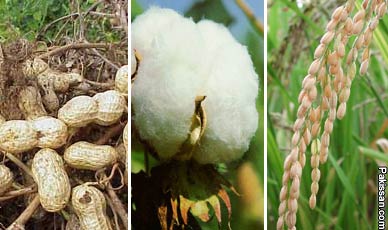|
Lower targets for cash crops
 ARGETS
for two cash crops - cotton and rice - have been fixed at
lessthan what the country achieved last year, leave alone
bumper andrecord yields of the past.This year, cotton target
has come down to 13.3 million bales againstlast season’s
production of 14.1 million bales. ARGETS
for two cash crops - cotton and rice - have been fixed at
lessthan what the country achieved last year, leave alone
bumper andrecord yields of the past.This year, cotton target
has come down to 13.3 million bales againstlast season’s
production of 14.1 million bales.
Similarly, rice targethas been fixed at six million tons
against 6.9 million tons producedlast year. The agriculture
planners defend these low targets saying it was
anextraordinary season last year and its production cannot
be taken asbenchmark. Thus, we have set targets, which are
achievable and providecredible basis for next year’s
planning, they say.
The farmers, however, insist these targets are low enough to
beachieved automatically, without creating any hassle for
agriculturebureaucracy. They claim: “Agricultural
bureaucracy has even stoppeddreaming about higher goals.”
The lower targets would translate into astaggering cost to
the economy. The country would have to import hugequantity
of cotton and lose money on rice exports, creating a
hugehole in its finances.
Where would it get the foreign exchange from tobridge the
gap, especially given the financial crunch it is facingright
now? Last year’s trade deficit amounted to $17 billion. If
the gap has tonarrow down, agriculture is perhaps the only
hope; the manufacturingsector is in negative swing. Growth
of services has slowed down. ThisKharif season assumes added
significance as it grows two major cashcrops.
Around 53-54 per cent of export earnings come only from
cotton andcotton textiles. In order to maintain that level
of exports, thetextile industry needs around 15 million
bales, but the target hasbeen set at 13.3 million bales. It
means the country is planning foran import of 1.7 million
bales. The planners have disregarded the factthat the
country had once produced 14.7 million bales. If Pakistan’s
effort is put in the Indian context, the target lookssimply
disappointing.
During the last 10 years, the Indian cottonproduction has
jumped from 17 million bales to 31 million bales. Mostof its
yield is coming from non-traditional (rain-fed) areas, where
itis watered with pressurised irrigation. Pakistan’s
agriculture is inthe hands advocates of status quo, as the
farmers claim. Rice, the second largest cash crop, presents
the same story. Lastyear, out of total production of 6.9
million tons, three million tonswere exported – 0.97 million
tons basmati and the rest non-basmati –for about $2.2
billion. Had it not been for gross under-invoicing –keeping
domestic market suppressed, less foreign exchange for
nationalexchequer and fewer taxes – the figure could have
touched $3 billion.
This year, the agriculture planners seem to be simply
planning toreduce exportable surplus. Instead of increasing
surplus and findingnew markets for it, rice import is being
put on a reverse path. The country is spending nearly $4
billion on import of what the StateBank of Pakistan calls
food group – wheat, edible fats, pulses anddiary products.
All of it belongs to the agriculture sector and itssub-sectors.
Even these $4 billion could be saved though betterplanning
to boost production in the agriculture sector. Planners need
to think big and devise strategies accordingly. It is,by all
means, a gigantic task, but has to be undertaken to prevent
aneconomic mess.
There are many states, endowed with much less than
Pakistan’spotential, which developed a vision, set goals and
targets and thenachieved these within a short span of time.
Chile is one such example;it raised its horticulture exports
from virtual zero to $6 billionwithin a decade. The Indian
agricultural production is also multiplying at a fasterpace
– doubling of cotton production in 10 years. All major and
minor crops and food group have their own set ofproblems and
need careful planning. But it is, by no means, animpossible
task; they rather need right steps to become basis forhigher
targets.
Pakistan’s cotton and rice crops are now witnessing invasion
byillegal varieties, and the issue is snowballing every
year. Thecountry needs to ensure genetic purity of both
crops as a first step.Secondly, it must bring in new and
better yielding varieties, whichare available all over the
world. Its 80 per cent cotton is underso-called BT variety,
and no one knows what is being sown in the nameof BT.
Its rice has just started suffering invasion of
hybridvarieties, which are of unknown origin and health. Its
main (basmati)variety, Super-96, is 13 years old and
becoming increasing susceptibleto diseases. All its coarse
varieties are vulnerable to blight and regularly fallvictim
to it. Both need replacement. These simple steps, along
withbetter extension service, would make huge difference in
these crops.But it needs some meticulous planning and a set
of objectives – put intimeframe.
Courtesy:
The DAWN
|
Pakissan.com;
|